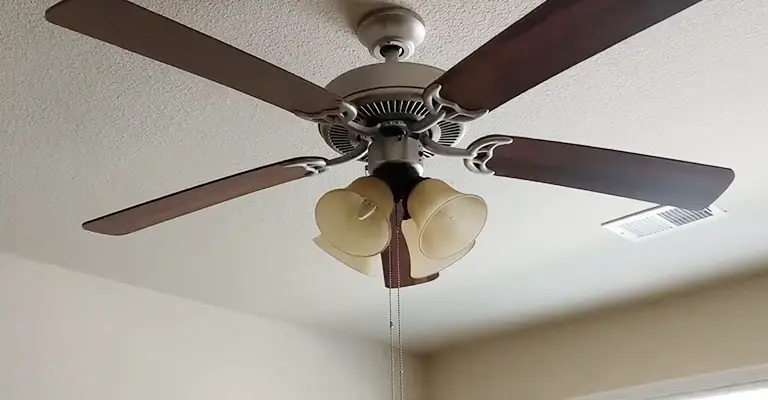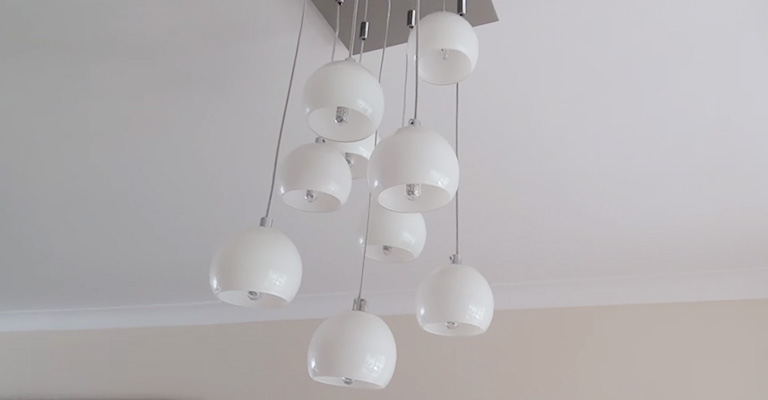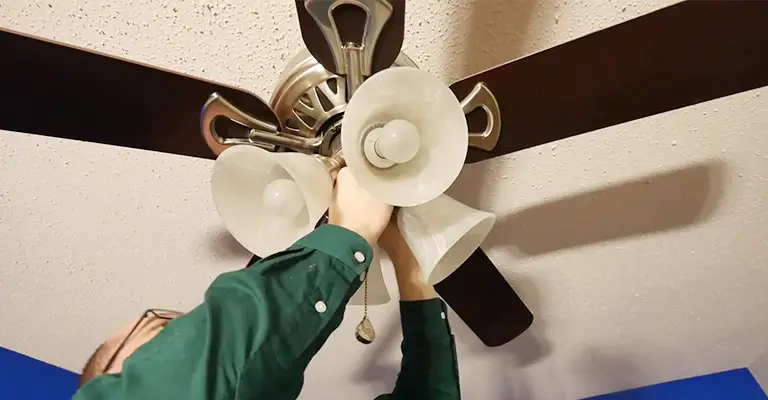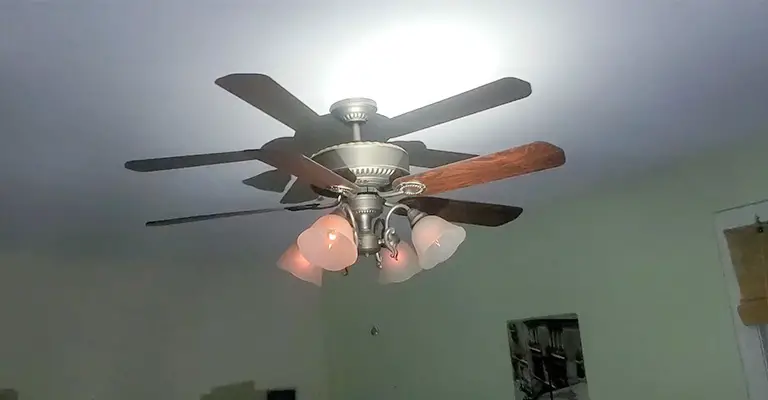A flickering LED ceiling light can be a maddening and puzzling issue in any room. Instead of providing steady illumination, it seems to have a mind of its own, intermittently flashing on and off.
In this article, we’ll delve into the common reasons why your LED ceiling light might be misbehaving, and we’ll guide you through practical steps to diagnose and resolve this irksome problem, ensuring consistent and reliable lighting in your space.
Why Is My LED Bulb Flickering?
Nowadays, LED lights are all the rage in the lighting industry, and it’s not hard to see why. It’s just that they’re better bulbs.
Their energy efficiency is very high and they have a very long life expectancy. LEDs provide cost-effectiveness and environmental protection, both of which contribute to their cost-effectiveness.
In addition to that:
- They are much stronger than most other lights due to their solid material
- Subzero temperatures are no problem for them
- There is no mercury in them
- In addition to color, brightness can also be customized
Considering all the advantages of LED lights, it’s no wonder they’re so in demand. However, like any product, there can be some problems with them.
LED owners may experience light flickering as a result of their lights. It’s good news that this problem is easily diagnosed and fixed.
No matter how long you have been using LED bulbs or how recently you have upgraded from incandescent bulbs, flickering can occur.
There may be an easy fix for flickering LED bulbs, but there are also times when more serious issues are present. If the wiring of your LED bulb is loose or if there is a voltage fluctuation, it can cause the bulb to flicker.
Possible Reasons for LED Light Flickering

Generally, LED bulbs flicker for reasons other than the LED bulb itself, and this is not related to the LED bulb.
There is probably something wrong with the current being fed through the bulb. When a current is uniform, the light is consistent, whereas if it is not uniform, flickering may occur.
Dimmer Switches
Dimmer switches that don’t work with LED lights are one of the most common causes. It is likely that you won’t be able to use an incandescent switch with LED lights if you already have one installed for an incandescent bulb. The installation of a more compatible switch is a simple process.
Wires
Having loose wires will definitely result in a non-uniform current, resulting in flickering lights. Make sure that loose wires are not the cause of the problem.
Wattage
When you first install your LED, you’re going to require more power than you will later on. LEDs can flicker due to the excess power they draw.
The fix will be easy if you know where your higher-voltage circuits are. If the flickering was caused by a low-voltage circuit in your LED light, move it to a higher-voltage circuit.
Driver Components
An LED lamp’s frequency can be regulated by constant current driver components. It is less likely for flickering to occur at a frequency that is stabilized.
Consider using some constant current driver components if you do not have any. You might not be getting the best results from the cheaper driver components already installed.
Relaxation Oscillator
You might be experiencing a flicker if you have a relaxation oscillator. When the LED lamp is off, this oscillator helps it to charge.
This switch, however, can cause a flicker if it happens to switch the lamp’s cycle to “charge” while it is still on.
LED Bulbs Flickering Without a Dimmer

When the dimmer malfunctions, LED light bulbs flicker. There are three possible causes of flickering LED lights: the bulb itself, the wiring, and the power source. If your LED lights don’t have a dimmer, the bulb itself, the wiring, or the power supply could be at fault.
Issues with the Bulb
Flickering LED lights can be caused by a faulty driver component in the bulb.
When the lights are turned on, the temperature generated by this component can become too hot for it to withstand. If this is the case, the capacitor within the bulb may appear bulgy or swollen.
Issues with Power
If your electrical panel has been damaged, this problem may occur. Your lights may not function properly if there is loose wiring in your circuit breaker.
LED bulbs could flicker if they are connected to the same circuit as incandescent bulbs. These bulbs and other appliances in your home are able to use the remaining energy provided by incandescent bulbs.
By using three or four incandescent bulbs simultaneously, you may consume all the available power.
Issues with Wiring
There is also a possibility that lights will flicker because the wire within the fixture is too short. A minimum length of 6 inches is required for all wires. It is possible for flickering to occur if the wires connecting the switch, the fixture, and the bulb are loose.
LED Bulbs Flickering with a Dimmer

There are two modes of operation for LED bulbs: off and on. When incandescent bulbs were switched on or off, older dimmers directly altered the amount of current being provided to them.
Old dimmers may not work properly with LED bulbs because of this difference in function.
You can upgrade your old dimmer switch to one designed for LED bulbs if your flickering is due to an old dimmer.
The number of LED light fixtures that come with dimmers is increasing, but not all of them provide dimmers. Non-dimmable LEDs can also flicker when used with modern dimmer switches.
Bulbs Flickering When Lights are Turned Off
Despite being switched off, your LED light bulb may still flicker. Smart switches are notorious for causing this problem in homes.
Dimmer switches, night lights, and WiFi control are some of the features included with smart switches.
To ensure that the smart features are always available, this type of switch requires a little standby power. A faulty smart switch might not be able to use a neutral wire if its circuitry is faulty.
Due to the fact that LED bulbs are located on a negative wire, an issue known as capacitive coupling could occur, which would lead to some power being stored in the capacitors.
It is inevitable that the voltage will build up within the light’s circuit, causing the bulbs to flicker or glow.
How to Stop Lights from Flickering?
The flickering may be resolved by using fewer electrical appliances simultaneously if the flickering is caused by voltage fluctuations.
The voltage levels will likely change if you run your dishwasher when five other electrical appliances are on, causing your lights to flicker.
In order to mitigate this problem, appliances that consume high amounts of electricity can be moved to circuits with 240 volts.
There may be additional electrical work needed if your existing panel doesn’t have enough room to accommodate 240-volt breakers.
The bulb may also be loosening due to debris or dirt, which can also be cleared with compressed air.
Electricians may need to tighten the wires if screwing the bulb in tighter doesn’t stop the flickering.
The switches people purchase are often not compatible with the lights they have purchased. LED lights must be compatible with the switch you buy. Bulb purchases are no different.
Flickering may still occur if you choose cheap LED lights. A professional electrician can address many of these issues.
Unless you are a professional, working on electrical appliances and outlets can be dangerous even if the problem is minor.
Indications that Flickering Issues are More Serious
There are also health risks associated with flickering lights. It is important to address the problem as soon as possible after the problem is identified since short-term exposure to frequencies between 3Hz and 70Hz can cause seizures.
Your home’s electrical system may also be malfunctioning if your lights flicker. There is a possibility that a circuit has become overloaded.
The problem should be diagnosed by an electrician in this case. Fires may be caused by electrical issues such as poor wiring or faulty circuit breakers.
The lights are usually damaged by an overloaded circuit breaker. Appliances can also be damaged from time to time, however.
How Professionals Handle Light Flickering Issues
It is possible to resolve this issue in several different ways if the problem is serious enough to warrant the attention of an electrician.
It may be necessary to use better drivers, for example. It is possible to eliminate flickering in some cases with the right drivers by eliminating power current peaks.
During a voltage change in your home, your electrical panel could be replaced to ensure that your home’s power needs are met.
The damaged component could be replaced altogether when the cause of the flickering is a malfunctioning component.
Final Words
It is sometimes difficult to resolve LED light flicker problems, as you might have realized after reading this article. A lighting specialist may be able to help you if you do not want to try to figure it out yourself.
Anyhow, it’s probably a good idea to consult with a lighting specialist before installing LED lights. Make sure you install the LED with compatible dimmers, the right circuit, etc.







